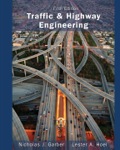
Concept explainers
The fundamental differences between how LOS is determined for the automobile mode compared to human-powered modes.
Explanation of Solution
Introduction:
The level of service is a term that is used to measure the quality of motor vehicle traffic service. The level of service is used for the analysis of roadways and intersection. It categorizes traffic flow and quality of the traffic based on some performance, measures such as traffic density, congestion, and speed.
For the automobile mode, LOS is computed by calculating the level of service at each lane group, intersections, and intersection approach. These are known as a control delay. Control delay is based on the performance measures of the traffic which are determined on the field.
The lane group level of service is calculated by considering both control delay, as well as volume to capacity ratio. But at the intersections, it is calculated only by considering the control delay. Control delay does not represent the consumption of fuel, and the travel time loss.
For the human-powered modes, the LOS is determined by considering the factors that can be described as either performance measures, such as pedestrian delay, and indicator of intersection characteristics as pedestrian corner circulation area, etc.
Conclusion:
Thus, for the automobile mode, LOS is computed by calculating the level of service at each lane group, intersection approach, and at intersections, and for the human-powered modes, the level of service is calculated by considering the pedestrian delay, pedestrian corner circulation area, etc.
Want to see more full solutions like this?
Chapter 10 Solutions
Traffic and Highway Engineering
- A trailer from a minor road joins a major road traffic stream having a flow of 2000 veh/hrand a density of 18veh/km. The heavy traffic in the opposite stream makes it difficult forvehicle to overtake it once in the traffic stream. The trailer moves at a speed of 60Km/hr forstretch of 15km. The effect of the entry of the trailer into the traffic stream is an increase inthe density of the traffic behind to 30 veh/Km. Determine the number of vehicles that willbe in the traffic stream when the trailer eventually leavesarrow_forwardA freeway traffic stream was observed to have a density of 22.0 veh/mi/ln when the mean speed was 55.0 mi/h. On another occasion at the same location, the jam density was found to be 132 veh/mi/ln. Assume Greenshields' model of traffic flow applies. The flow rate (in veh/h/ln) at the time when the mean speed was 55.0 mi/h is: 990 1210 1540 2178 None of the abovearrow_forwardA stream of traffic moving at a speed of 40km/h and a concentration of 20veh/km is stopped for 2mins by a herd of cattle crossing the road. After the herds departure, the vehicles began moving at a speed of 20km/h and a concentration of 60veh/km. Assuming a jam concentration of 150veh/km, calculatei. The velocity and direction of the stopping waveii. The length of the line of cars stopped during the 2mins periodiii. The number of cars stopped during the 2minsiv. The velocity of the shock wave resulting from the dissipation of the queuearrow_forward
- It is the maximum safe operating speed under favorable vehicle, highway, and weather condition.arrow_forwardOn a specific westbound section of highway, studies show that the speed-density relationshipisarrow_forward4. A driver on a level two-lane highway observes a truck completely blocking the highway. The driver was able to stop her vehicle only 20 ft from the truck. If the driver was driving at 60 mi/h, how far was she from the truck when she first observed it?arrow_forward
- You are to determine the duration of the yellow light at a highway intersection. Assume that cars will be approaching the intersection traveling at 70 mph, and that the reaction time of the driver is 2.5 sec and that cars achieve a deceleration of 1/8 of the gravitational acceleration. if g=32.2 fps^2, a. how long must the traffic light remain yellow to allow drivers to come to stop before the traffic light turns red? b. what is the minimum distance of a car from the intersection when the lightturns yellow to ensure that it comes to a full stop before the intersection?arrow_forwardOn a freeway with a flow of 1600 vehicles per hour and an absolute maximum space mean speed of 110mph, the following point speeds were observed (in mph): 52,48,58,43,58,54,62,51,58,55,59,59,53,50,54. Determine the jam density, in vehicles per mile.arrow_forwardA segment of a highway was designed for a free flow speed of 90 mph. At the time of observation along the segment, it was recorded that same segment was at its maximum flow. What is the average speed of vehicles at this instant?arrow_forward
- Using a surveillance camera, 15 vehicles were observed within 350 m section of the innermost lane of the North Luzon Expressway. Estimate the average spacing of these vehicles.arrow_forwardA motorcycle patrolman starts from rest at A 2 sec. after a car speeding at the constant rate of 120 kph passes point A. If the patrolman accelerates at the rate of 6 m/s2 until he reaches his maximum permissible speed of 150 kph, which he maintains. a. Find the time for the patrolman to reach a maximum permissible speed of 150 kph. b. How long did it take the patrolman to overtake the car from the time he starts from A.? c. Calculate the distance S from point A to the point at which he overtakes the car.arrow_forwardA freeway traffic stream was observed to have a density of 22.0 veh/mi/ln when the mean speed was 55.0 mi/h. On another occasion at the same location, the jam density was found to be 132 veh/mi/ln. Assume Greenshields' model of traffic flow applies. The optimum speed (in mi/h) is: a) 22.0 b) 33.0 c) 55.0 d) 66.0 e) None of he abovearrow_forward
 Traffic and Highway EngineeringCivil EngineeringISBN:9781305156241Author:Garber, Nicholas J.Publisher:Cengage Learning
Traffic and Highway EngineeringCivil EngineeringISBN:9781305156241Author:Garber, Nicholas J.Publisher:Cengage Learning
